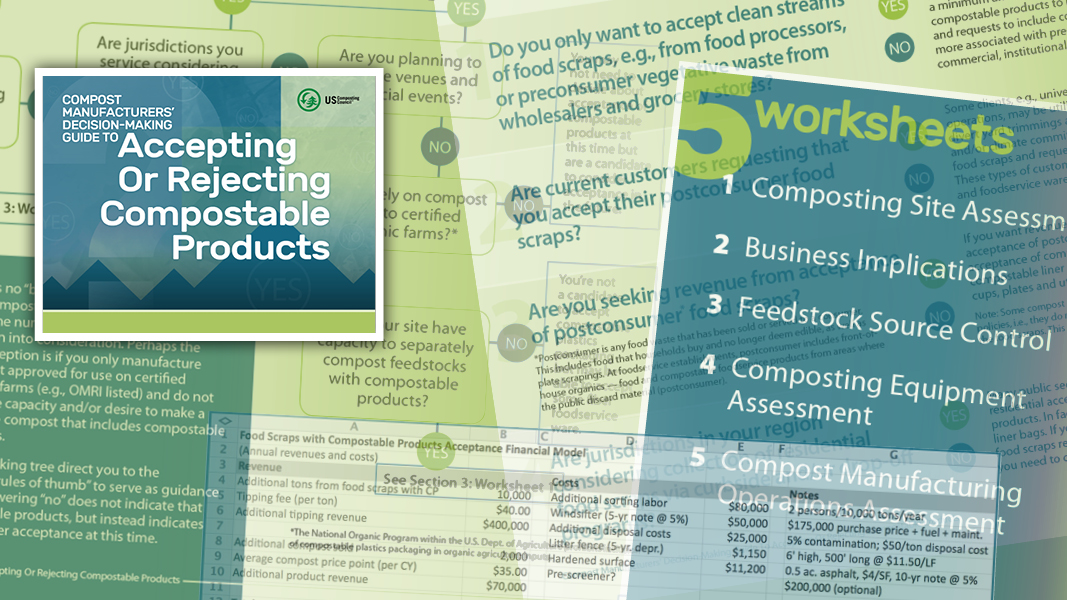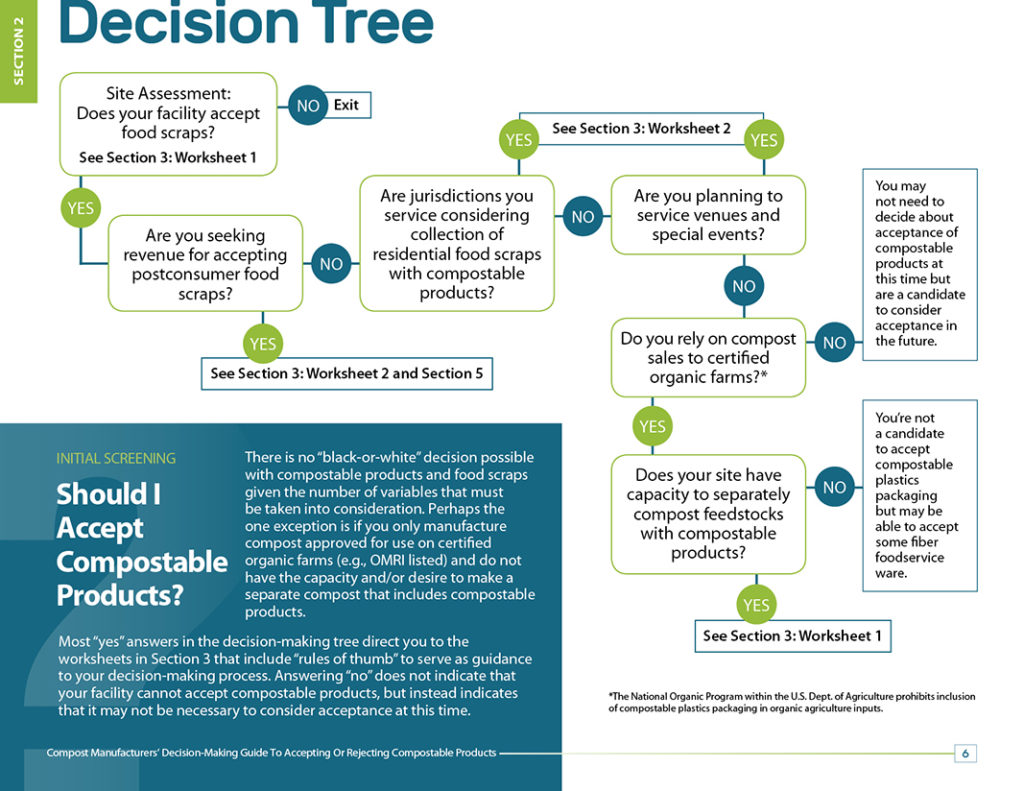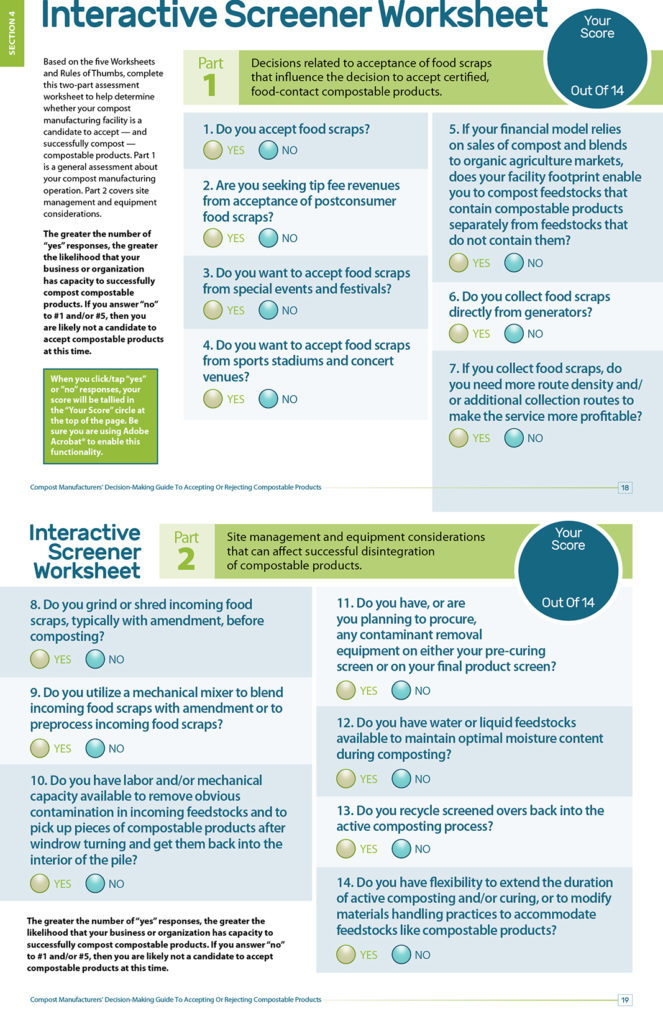Nora Goldstein and Craig Coker
The U.S. Composting Council’s (USCC) Compost Manufacturers’ Decision-Making Guide To Accepting Or Rejecting Compostable Products walks through numerous variables that factor into deciding whether or not to accept certified compostable products. The goal of this document is to help compost manufacturers think through the various considerations of a decision to accept food scraps at their composting facilities, which will engender a need to plan for managing the compostable products that will accompany those scraps.
BioCycle Associates, under contract with the USCC, utilized a five-step approach to developing the Decision-Making Guide:
- Conduct a survey of compost manufacturers about their composting practices, whether they accept certified compostable products and if so, the “fate” of those products in their operations. The survey also asked about food scraps collection and preprocessing steps.
- Interview compost manufacturers to learn more about their responses to the questionnaire.
- Utilize the questionnaire framework, e.g., Yes/No questions about acceptance of certified compostable plastics and fiber and requirements for their acceptance, to inform the Decision-Making Guide, including the decision tree.
- Create worksheets for compost manufacturers to guide their decisions at each step in the decision tree.
- Utilize feedback from USCC Workshops and Summit (June and July, 2021) on compostable products to refine the decision tree, worksheets and other elements of the Decision-Making Guide.
The “companion” document to the Decision-Making Guide (DMG), also written by BioCycle Associates as part of its contract with USCC, is Compostable Products: A Primer For Compost Manufacturers, released by the USCC in June 2021. The Primer covers all the basic details about certified compostable products, which are not included in the DMG.
The categories of compostable products discussed in the Guide are related to source separated commercial, residential and institutional organic waste streams that include food scraps, and to a much lesser extent, yard trimmings. The DMG is focused on compostable products certified to meet ASTM D6400 and D6868 standards and meet BPI (Biodegradable Products Institute) limits on fluorine content.
The intent of the DMG is to both assist with the assessment of accepting or not accepting compostable products and to highlight critical control points — from collection to end product markets — that need to be considered to successfully compost these products if accepted. Content in the DMG is based on research conducted to write the Primer, the authors’ knowledge and experience and, most importantly, the experiences of compost manufacturers who shared their data and lessons learned.
Survey And Interviews
The questionnaire developed to collect compost manufacturers’ experiences with compostable products asked about the composting process, including incoming materials processing, length of active and curing phases, average temperature and moisture content during the entire process, if compost is screened before and/or after curing, whether overs are recycled back into the active composting phase, etc. The next set of questions focused on compostable products accepted or not accepted. For compost manufacturers that do not accept compostable products, the survey asked them to indicate why, e.g, does not break down in my composting process, jeopardizes my OMRI listing, does not result in higher volumes of food scraps, etc.
A set of questions was asked about the compostability of accepted products, i.e., rate of breakdown, at their facility. These included how the compost manufacturer defines and measures disintegration, when in the process the products completely disintegrate or if they did not disintegrate, and observations on how to improve disintegration at their composting facility.
Interviews were conducted with a number of the compost manufacturers. The collected data and lessons learned were synthesized into the general observations about compostable products, the Decision Tree, the assessment worksheets and the final “interactive screener” worksheet. During the review process of the DMG, it was suggested that a financial assessment spreadsheet be included. That is in Section 5 of the DMG.
Compostable Products Composting Observations
Section 1 of the DMG is Compostable Products Composting Observations — essentially the main takeaways gleaned from writing the Primer and the DMG. The 9 observations are:
- Contamination from non-compostables is often the primary problem for compost manufacturers, not the compostable products themselves. Some composters may view compostable products that have not broken down and are appearing in the final compost as contaminants.
- Generally speaking, compost manufacturers are not seeking compostable products as a feedstock. Instead, compostable products are often an inherent part of accepting postconsumer food scraps for composting and are actually a “tool” to help procure food scraps from generators.
- Confusion generally about sorting (what goes in which bin) and more specifically about products that look similar to compostable products (aka “lookalikes”) often results in non-compostables contamination in the compostables stream.
- Successful disintegration (physical and visual breakdown) is composting method agnostic, i.e., compostable products disintegrate using all methods (windrows, individual aerated static piles (ASP), extended ASPs, in-vessel systems), although the rate of disintegration may differ based on the method.
- Conditions that are optimal for composting are also optimal for disintegration of compostable products.
- Compostable liner bags increase participation in food scraps diversion programs, mimicking the behavior with trash bags.
- Source control (at point of generation) is paramount but does not prevent contamination — whether compostable products are accepted or not.
- Thickness may matter, i.e., the thickness of the compostable products themselves impacts rate of disintegration in the composting process (akin to wood chips vs. wood shavings).
- Size reduction helps increase surface area for biological degradation (just like grinding/shredding wood). It also assists with opening compostable liner bags, and/or to mix and homogenize compostable products with other feedstocks prior to introducing them into the compost piles.
Decision Tree: Should I Accept Compostable Products?
There is no “black-or-white” decision possible with compostable products and food scraps given the number of variables that must be taken into consideration. Perhaps the one exception is if you only manufacture compost approved for use on certified organic farms (e.g., OMRI listed) and do not have the capacity and/or desire to make a separate compost that includes compostable products.
The Decision Tree is shown in Figure 1. Most “yes” answers in the decision-making tree direct you to the worksheets in Section 3 that include “rules of thumb” to serve as guidance to your decision-making process. Answering “no” does not indicate that your facility cannot accept compostable products, but instead indicates that it may not be necessary to consider acceptance at this time.
BioCycle and the USCC sought input from compost manufacturers who accept compostable products but do not accept food scraps, e.g., yard trimmings composting facilities. None were identified, which is not surprising as certified compostable liner bags and foodservice ware products and packaging are more associated with food scraps streams. This reality is translated into the very first box of the Decision Tree, which asks: Does your facility accept food scraps? If you respond no, the Decision Tree prompts you to exit the evaluation process.
Assessment Worksheets
This section contains five worksheets; each addresses a different component of compost manufacturing. These worksheets utilize a Yes/No format, followed by Rules of Thumb that explain factors to consider as you answer the questions. They are designed as a resource/guidance tool. The five topic areas and a sample question and Rules of Thumb for each are:
Composting Site Assessment
Question: Does your facility footprint enable you to compost feedstocks that contain compostable products separately from feedstocks that do not contain compostable products?
Rule of Thumb: Facilities with adequate land area may create a second composting “line” for feedstocks with compostable packaging to continue producing a compost for use on certified organic farms and/or to manufacture a compost that is free of contamination, e.g., for bagging or end users that have zero tolerance for presence of contamination. Manufacturers without capacity for separate composting lines will need to weigh the pros and cons of introducing food scrap streams with compostable products and the potential for contamination from lookalike products.
Business Implications
Question: Are current customers requesting that you accept their postconsumer food scraps?
Rule of Thumb: Some clients, e.g., universities and corporate campuses with foodservice operations, may be utilizing your collection and composting services to divert yard trimmings and other landscape residuals. To achieve zero waste and/or climate commitment goals, they would like to start diverting their preconsumer and postconsumer food scraps and request that your company provide the collection service. These types of customers may also want to include compostable liner bags and foodservice ware.
Feedstock Source Control
Question: If you collect food scraps, do you supply (or help source for customers) compostable liner bags?
Rule of Thumb: Given the nature of food scraps being wet and often smelly, collection service providers — and the generators themselves — frequently utilize compostable liner bags. This also reduces the need to wash out carts during collection, or to swap out filled, unlined containers with clean ones. Some generators also want to use cart liners in their kitchens and public collection areas. And many residential food scraps collection programs accept compostable liner bags (for countertop containers and buckets/cart) to address the “yuck” factor related to accumulated food scraps. Finally, some organics haulers equip their trucks with cart washing equipment versus accepting compostable cart liner bags. Washing can hamper collection efficiency. (Some haulers utilize compostable liner bags and will rinse out the cart after emptying as a good housekeeping practice.)
Composting Equipment Assessment
Question: Does your facility have, or are you planning to procure, food waste depackaging equipment?
Rule of Thumb: Depackaging equipment does not distinguish between compostable products and single-use plastics and other noncompostable items and thus will remove the majority of them from the incoming food scraps stream. Food scraps generators may be spending more money on compostable product alternatives and assume that they will be composted by participating in an organics collection program. Food scraps customers should understand if you have, or plan to have, a depackager.
Compost Manufacturing Operations Assessment
Question: Do you recycle screened overs back into the active composting process?
Rule of Thumb: Compost manufacturers frequently recycle screened overs back into the front end of the system, both to further break down feedstocks and to inoculate fresh material to jump start the decomposition process. Recycling overs helps to complete disintegration of compostable products. If food scraps streams contain high levels of contamination — thus contaminating the overs — compost manufacturers may be reluctant to recycle them.
Interactive Screener Worksheet
Based on the five Worksheets and Rules of Thumbs, an Interactive Screener Worksheet was created (Section 4). The two-part assessment worksheet (Figure 2) is a tool to help determine whether your compost manufacturing facility is a candidate to accept — and successfully compost — compostable products. Part 1 is a general assessment of your compost manufacturing operation. Part 2 covers site management and equipment considerations.
The worksheet tallies the number of “yes” responses. The greater the number of “yes” responses, the greater the likelihood that your business or organization has capacity to successfully compost compostable products. If you answer “no” to #1 and/or #5, then you are likely not a candidate to accept compostable products at this time.
Section 5 of the DMG is titled, The Bottom Line. “In the end, the decision comes down to the financial viability of accepting food scraps with compostable products included,” notes the DMG. “Will it result in greater volumes of food scraps overall? How does it impact the bottom line?”
Additional capital costs for collection containers and trucks, contaminant removal technologies, site improvements, permit modifications, among others, may be incurred when the decision is made to accept food scraps — especially postconsumer food scraps with or without inclusion of certified compostable products. There will be additional operating costs for collection labor, load inspections, contaminant removal and materials handling. A sample Excel spreadsheet, titled Food Scraps with Compostable Products Acceptance Financial Model, is presented to help composter manufacturers understand how to do an assessment.
The Compost Manufacturers’ Decision-Making Guide To Accepting Or Rejecting Compostable Products can be downloaded from the USCC’s website.
Nora Goldstein and Craig Coker are Editor and Senior Editor, respectively, of BioCycle CONNECT and associates of BioCycle Associates. Craig Coker also is a Principal in the firm Coker Composting & Consulting, near Roanoke, VA. Design and graphics for the Decision-Making Guide (and in this article) are by Doug Pinkerton, BioCycle Associates.















